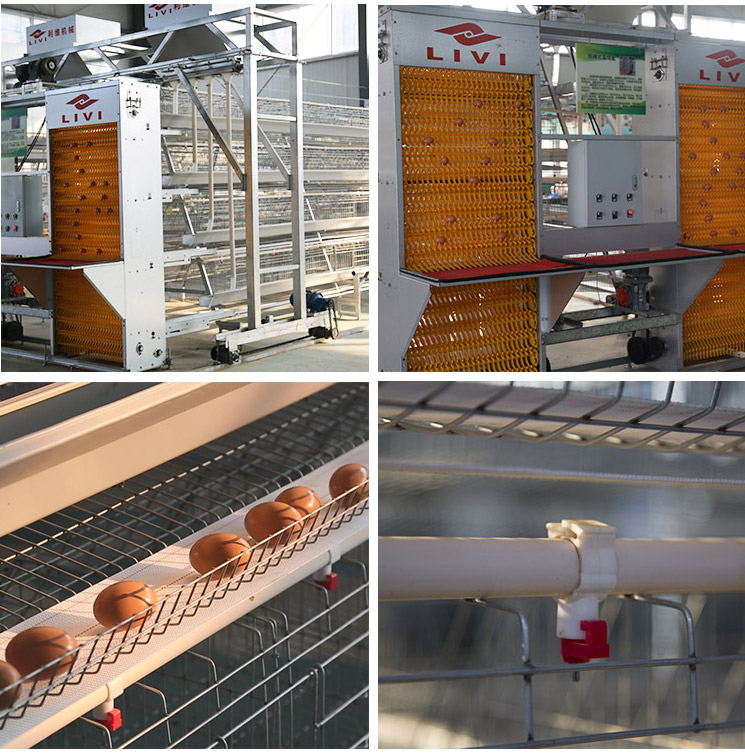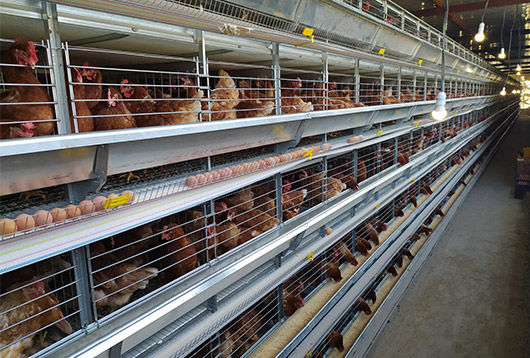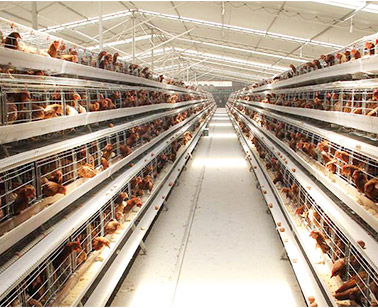Poultry farming battery cage system can boost productivity
Battery cage systems are now very popular in modern poultry farms. Advanced breeding technology and breeding programs can only be realized with the support of poultry equipment.
The battery cage for layer in poultry farms has a large number of breeding and high stocking density, making full use of the space of the chicken house and saving construction costs. There are generally more than 5,000 laying hens in chicken cages. Each group of chicken coops can house 90-160 birds. The cascading rearing has high breeding density.

The chicken layer cages is generally 3 or 4 tiers. Customized services can also be implemented, up to 8 tiers. And the floor area is relatively small, and the interval between each row of chicken cages is about 1.5 meters.
The height of the chicken cages also increases with the height of the layered chicken house. Generally, for three-layer or four-tier cages, each row of cages should be 50 cm away from the top of the chicken house. This prevents the chicken coop from making full use of the building space and increases the density of poultry breeding by at least 3 times.
At the same time, high stocking densities are accompanied by high automation. Automatic poultry drinking equipment, automatic feeding equipment, automatic manure cleaning equipment, automatic egg collection equipment, automatic environmental control system, etc. The use of these equipment not only increases the density of poultry breeding, but also makes your profits get results faster.
Farms using poultry equipment are mechanized and have a high degree of automation. Commercial battery cages for sale operate stably, with low failure rate and less maintenance. Breeders basically do not need to enter the chicken coop, and only need to press the button lightly to achieve automatic drinking water, feeding, egg collection, manure cleaning, ventilation and other tasks. 1 person can easily manage a chicken coop of 30,000 birds.

Advanced equipment promotes the economic improvement of the chicken industry. Due to the high quality of the equipment, efficient breeding and other characteristics. The high degree of automation realizes easy management by one person, etc. The transmission route of the disease is greatly reduced, and the incidence of chickens is greatly reduced. As a result, the mortality rate of chickens was reduced by about 5%.
Finally, poultry farmers must choose reliable chicken cage manufacturers when purchasing poultry cages. Quality poultry farm feeding equipment can increase the efficiency of the farm. And offers durable poultry equipment and great prices.
How to Buy the Right Battery Cage System in Ghana?
Now the poultry farming project in Ghana is hot, it is the golden age of poultry farming development. More and more poultry farmers are choosing battery cage systems in Ghana to develop projects. But how to buy a suitable poultry chicken cages?
There are many different sizes and types of battery cages on the market. In fact, it is best to choose a chicken coop that is suitable for your poultry farm.
You can choose the right battery cage based on the weight and size of your poultry and the climate in your country. For example, 1.5KG and 2.5KG require different size layer cages. The lifespan of a laying hen of the same quality can vary greatly in hot and cool weather. There are large and small spaces, and if the area is large, you can choose A-type chicken cages or H-type chicken cages. So layer cage price in Ghana is not the only consideration.

How to choose the poultry farming equipment you need in Ghana?
If you have less than 2000 chickens, we recommend that you only buy poultry cages. The drinking system is automated, but workers manually feed the chickens, collect eggs, and remove manure.
If you have 5,000 - 10,000 chickens, we recommend that you purchase a manure removal machine with a battery box. By removing feces in a timely manner, you can reduce the likelihood of disease, increase egg production, and save more time and labor costs. The scraper type manure remover is the most economical one. A semi-automatic chicken feeder also requires this number of chickens. It is small and cheap automatic chicken feeder, and because it uses a battery cage, you will avoid the inconvenience of power failure. You can feed 10,000 chickens in half an hour and save a lot of labor.
If you have more than 10,000 laying hens, you may need fully automatic equipment including battery chicken cages for sale, automatic chicken feeders, automatic egg collectors, and manure shovels (automatic manure removal systems). If your operation is larger than 50,000 chickens, you will need a feed silo. For fewer than 50,000 chickens, you can use just one screw conveyor to deliver the food to the hopper.
If you want to build a closed system, you need to know that exhaust fans and cooling pads are necessary items of environmental control equipment. If you are using an open system and the weather is hot, you can use an atomizer.
How to scientifically disinfect poultry farms?
If the chicken house is not disinfected, it will provide a good living environment for many pathogenic microorganisms. And now that poultry battery cages are widely used in poultry farms, disinfection of chicken houses has become a top priority.
Disinfection methods commonly used in chicken production
There are generally three methods of disinfection in chicken farms (with chicken disinfection, drinking water disinfection and environmental sanitation disinfection). These three disinfection methods can respectively cut off the transmission routes of various pathogenic microorganisms.
Disinfection with chicken (spray) can kill pathogenic microorganisms in the air of the chicken house, the surface of the chicken body, the ground and the walls. It is of great significance to prevent the infection of chicken respiratory diseases. In addition, the concentration of harmful gases in the chicken house is reduced, and the effect of heatstroke prevention and cooling can be achieved at the same time.
Drinking water disinfection can kill pathogenic microorganisms in the drinking water of chickens and can purify the intestines. Scientific and reasonable disinfection of drinking water can reduce the occurrence of intestinal diseases in chickens, but it has no effect on preventing respiratory diseases, and needs to be combined with chicken (spray) disinfection.
Environmental sanitation and disinfection include disinfection of chicken farm grounds, chicken farm aisles and transportation vehicles. There are many farmers who often drink disinfectant for chickens, thinking that chickens will not develop diseases. In fact, this is a wrong understanding.

Precautions for disinfection of chicken farms with layer cage systems
Disinfection needs to be done continuously. The disinfection of chicken farms is a continuous preventive work, and the disinfection time is uninterrupted. It is better to do it once every 4 to 5 days during the breeding period; it is better to disinfect it once a week during the egg laying period. Drinking water disinfection is generally 1 to 2 times a week, 3 to 4 hours each time. Note that 3 days before and after the epidemic prevention, as well as on the day of epidemic prevention and during the medication period, the drinking water of the chickens cannot be disinfected.
Choose the right sanitizer. Using only one type of disinfectant can easily cause pathogenic bacteria to develop drug resistance, and the same batch of chickens should alternately use disinfectants.
The above are the three methods and precautions for disinfection of poultry farms shared by battery cage manufacturers. I hope there is a place that can help poultry farming friends.
